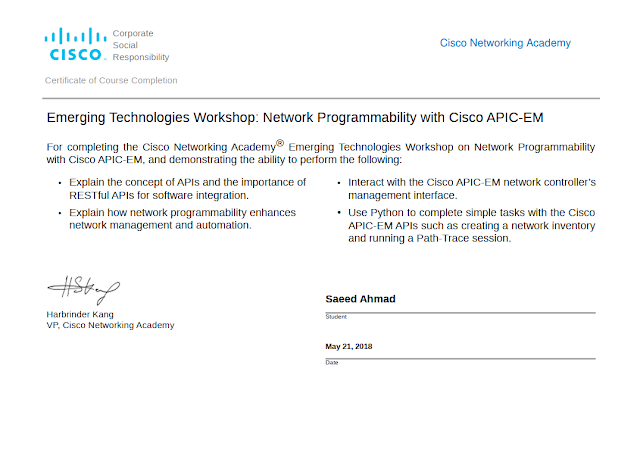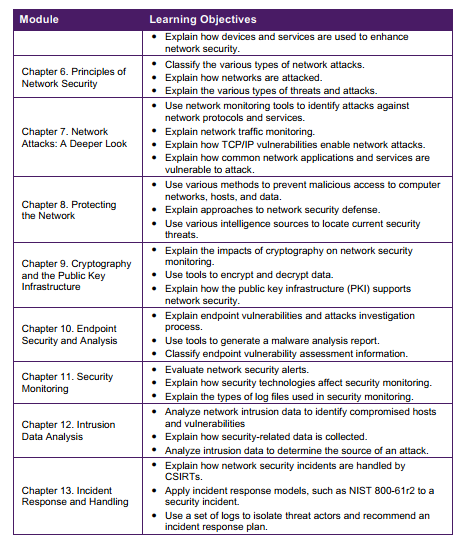CCNA R&S: Introduction to
Networks
CCNA Routing & Switching
Curriculum
Course Overview
CCNA R&S: Introduction to Networks (ITN) covers networking
architecture, structure, and functions. The course introduces the principles
and structure of IP addressing and the fundamentals of Ethernet concepts,
media, and operations to provide a foundation for the curriculum.
By the end of the course, students will be able to:
- Explain network technologies.
- Explain how devices access local
and remote network resources.
- Describe router hardware.
- Explain how switching operates in
a small to medium-sized business network.
- Design an IP addressing scheme to
provide network connectivity for a small to medium-sized business network.
- Configure initial settings on a
network device.
- Implement basic network
connectivity between devices.
- Configure monitoring tools
available for small to medium-sized business networks.
The 70-hour, instructor-led course is the 1st of 4 courses in
the Cisco CCNA Routing and Switching curriculum. The course includes activities
using Packet Tracer, hands-on lab work, and a wide array of assessment types
and tools.
CCNA R&S: Routing
and Switching Essentials
CCNA Routing & Switching
Curriculum
Course Overview
CCNA R&S: Routing and Switching Essentials (RSE) covers
the architecture, components, and operations of routers and switches in a small
network. Students learn how to configure a router and a switch for basic
functionality.
By the end of the course, students will be able to:
- Determine how a router will
forward traffic based on the contents of a routing table.
- Explain how switching operates in
a small to medium-sized business network.
- Use monitoring tools and network
management protocols to troubleshoot data networks.
- Configure monitoring tools available
for small to medium-sized business networks.
- Configure initial settings on a
network device.
- Configure Ethernet switch ports.
- Implement VLANs.
- Implement static routing.
- Implement DHCP on a router.
- Implement network address
translation (NAT).
- Implement access control lists
(ACLs) to filter traffic.
The 70-hour, instructor-led course is the second of 4 courses in
the Cisco CCNA Routing & Switching curriculum. The course includes
activities using Packet Tracer, hands-on lab work, and a wide array of assessment
types and tools.
CCNA R&S: Scaling Networks
CCNA Routing & Switching
Curriculum
Course Overview
CCNA R&S: Scaling Networks (ScaN) covers the architecture,
components, and operations of routers and switches in larger and more complex
networks. Students learn how to configure routers and switches for advanced
functionality.
By the end of this course, students will be able:
- Configure and troubleshoot
routers and switches
- Resolve common issues with OSPF,
EIGRP, and STP in both IPv4 and IPv6 networks
- Implement a WLAN in a
small-to-medium network
The 70-hour, instructor-led course is the 3rd of 4 courses in
the Cisco CCNA Routing & Switching curriculum. The course includes
activities using Packet Tracer, hands-on lab work, and a wide array of assessment
types and tools.
CCNA R&S: Connecting
Networks
CCNA Routing & Switching
Curriculum
Course Overview
CCNA R&S: Connecting Networks (CN) discusses the WAN
technologies and network services required by converged applications in a
complex network. The course enables students to understand the selection
criteria of network devices and WAN technologies to meet network requirements.
By the end of this course, students will be able:
- Configure and troubleshoot
network devices
- Resolve common issues with data
link protocols
- Resolve common issues with OSPF,
EIGRP, and STP in both IPv4 and IPv6 networks
- Implement virtual private network
(VPN) operations in a complex network
The 70-hour, instructor-led course is the 4th of 4 courses in
the Cisco CCNA Routing & Switching curriculum. The course includes
activities using Packet Tracer, hands-on lab work, and a wide array of
assessment types and tools.
CCNA R&S 6.0: Bridging
CCNA Routing & Switching
Curriculum
Course Overview
CCNA R&S 6.0: Bridging is an interim solution to address
the certification gap for the newly released Cisco CCENT and CCNA Routing
and Switching Certifications until the new CCNA R&S 6.0 courses are
available.
Summary of Additions
- CCNA R&S: Introduction to
Networks now includes extended traceroute activities and more practice in
debugging and network troubleshooting.
- CCNA R&S: Routing and
Switching Essentials has added material related to host routes, device
discovery, NTP, and password recovery.
- CCNA R&S: Scaling Networks
has added VTP, extended VLANS, and DTP. You will also learn more about
troubleshooting multi-VLAN and multi-area OSPF, switch stacking, and how
to implement HSRP.
- CCNA R&S: Connecting Networks
has the most updates with new content in the areas of: WAN topologies, IP
errors, security best practices, quality of service, cloud and
virtualization, and network programming.
Requirements
The curriculum is appropriate for students at many education
levels and types of institutions, including high schools, secondary schools,
universities, colleges, career and technical schools, and community centers.
For Students
Certification and Careers
The CCNA Routing & Switching curriculum helps students
develop workforce readiness skills and builds a foundation for success in
networking-related careers and degree programs.
 |
| Cisco Expert Level Instructor Award Saeed Ahmad CNAGuru |









